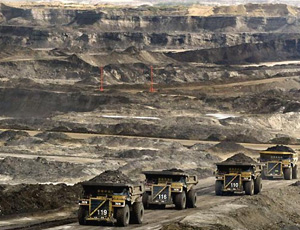China Looks at Canadian Oil Sands to Help Satiate Future Energy Demand
By Kaitlin Shung
 Jun. 30 – Chinese energy companies are looking to grab a stake in western Canada’s abundant oil sands to support China’s growing and developing appetite for oil.
Jun. 30 – Chinese energy companies are looking to grab a stake in western Canada’s abundant oil sands to support China’s growing and developing appetite for oil.
Despite an increasing awareness of environmental issues and movement towards cleaner forms of energy, reality still dictates that the majority of the world runs on oil. For emerging economies like China and India, their demand for this resource isn’t likely to level out any time soon. That being said, turmoil in the Middle East and fluctuating oil prices mean that governments and companies alike are searching for safer, more reliable alternatives.
Alberta, a resource rich province in western Canada, is home to the world’s third largest crude oil reserves in the form of the oil sands. Oil sands are pockets of bitumen (a form of oil mixed with sand and water) and sediment. When heavily processed, the oil in bitumen is extracted and refined into crude oil. With Alberta’s oil sand resources capable of producing an estimated 171.3 billion barrels of oil, there’s immense potential in this energy source which could help meet the future demand of both China and the United States.
The Alberta oil sands are particularly attractive to Chinese investors because the resources aren’t nationally owned and are therefore open to private investment. According to the Canadian Association of Petroleum Producers, the Alberta oil sands represent 52 percent of the world’s total crude resources available to private investors.
A relevant perspective in the dialogue regarding this type of unconventional petroleum deposit is the environmental impact. Oil sands are frequently referenced as “dirty oil” because of the resources and refining needed to process it. However, the main challenges facing China’s investment activities in the Alberta oil sands aren’t necessarily related to the environment, but are rather related to the diplomatic maneuvering of Canadian and American stakeholders.
A Chinese investment would require a pipeline to be built from Alberta to the western coast of British Columbia, in order to access the Pacific Ocean. China’s Sinopec has already invested US$5.5 billion in Canadian company Enbridge Inc.’s Northern Gateway Pipeline, which will eventually transfer oil from Alberta to British Columbia. However, the project faces tough opponents who are concerned with potential leakages and accidents, while it has yet to break ground because of serious questions about adequate due diligence.
Another important, and certainly not silent, player in this picture is the United States. The United States is currently Canada’s largest oil importer as well as the largest consumer of oil from Alberta’s oil sands, and that is unlikely to change any time soon. However, the oil sands draw a strong negative environmental association in North America and hesitation on the part of the Americans creates an opportunity for Chinese investors, as Canadian producers look to diversify their export partners. Questions have been raised by Canadian producers about how their American neighbors will respond to a perceived closeness with China, but this is unlikely to deter partnerships with Chinese companies.
“We’re not the 51st state. It’s not the business of the United States to decide where Canada sells its resources,” Edie Goldenberg, chief of staff to former Canadian Prime Minister Jean Chretien, said once in an interview.
Chinese producers also need to pay heed to the political environment in Canada, as the federal government has been historically wary of overly dominant Chinese control of Canadian resources. Take for example the central government’s rejection in 2005 of China Minmetals Corporation’s efforts to buy Noranada Inc., a key player in the Canadian mining industry.
Demand for Alberta’s oil sands isn’t unlikely to wane, despite environmental concerns, and Chinese companies making a move in Alberta are certainly looking towards the future. For Chinese companies, success in Alberta may be more contingent on patience than anything else.
Related Reading
Chinese Investment in the West: Drop the Labor, then Do the Math
CNOOC to Invest Over US$1 Billion in U.S. Shale Assets
Sino-Forest Sees Paulson & Co Sell Out As Fraud Allegations Linger
- Previous Article Wen Jiabao’s European Tour Focuses on Greater Cooperation, Business Opportunities
- Next Article New Issue of China Briefing: Trading and the Rise of FICE




























